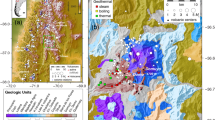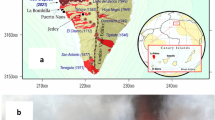Abstract
Volcanic eruptions often occur simultaneously1,2,3,4 or tap multiple magma reservoirs5,6. Such lateral interactions between magmatic systems are attributed to stress changes7,8 or hydraulic connections4,8,9,10 but the precise conditions under which coupled eruptions occur have yet to be quantified. Here we use interferometric synthetic aperture radar satellite data to analyse the surface deformation generated by volcanic unrest in the Kenyan Rift. We identify several magma sources located at depths of 2–5 km; importantly, sources that are spaced less than about 10 km apart interact, whereas those spaced more than about 25 km apart do not. However, volcanoes up to 25 km apart have interacted in the geologic past1,11. Thus, volcanic coupling is not simply controlled by the distance between the magma reservoirs. We then consider different tectonic settings globally, including intraplate volcanoes such as Hawaii and Yellowstone, arc volcanism in Alaska and Chile, and other rift settings, such as New Zealand, Iceland and Afar. We find that the most closely spaced magmatic interactions are controlled by the extent of a shallow crystal mush layer, stress changes can couple large eruptions over distances of about 20–40 km, and only large dyke intrusions or subduction earthquakes could generate coupled eruptions over distances of about 50–100 km.
This is a preview of subscription content, access via your institution
Access options
Subscribe to this journal
Receive 12 print issues and online access
$259.00 per year
only $21.58 per issue
Buy this article
- Purchase on Springer Link
- Instant access to full article PDF
Prices may be subject to local taxes which are calculated during checkout


Similar content being viewed by others
References
Scott, S. C. & Skilling, I. P. The role of tephrachronology in recognizing synchronous caldera-forming events at the Quaternary volcanoes Longonot and Suswa, south Kenya Rift. Geol. Soc. Spec. Publ. 161, 47–67 (1999).
Bégué, F. et al. Extraction, storage and eruption of multiple isolated magma batches in the paired Mamaku and Ohakuri eruption, Taupo Volcanic Zone, New Zealand. J. Petrol. 55, 1653–1684 (2014).
Hildreth, W. The timing of caldera collapse at Mount Katmai in response to magma withdrawal toward Novarupta. Geophys. Res. Lett. 18, 1541–1544 (1991).
Eichelberger, J. C. & Izbekov, P. E. Eruption of andesite triggered by dyke injection: contrasting cases at Karymsky volcano, Kamchatka and Mt Katmai, Alaska. Phil. Trans. R. Soc. Lond. A 358, 1465–1485 (2000).
Cooper, G. F., Wilson, C. J., Millet, M.-A., Baker, J. A. & Smith, E. G. Systematic tapping of independent magma chambers during the 1 Ma Kidnappers supereruption. Earth Planet. Sci. Lett. 313, 23–33 (2012).
Larsen, J. F., Śliwiński, M. G., Nye, C., Cameron, C. & Schaefer, J. R. The 2008 eruption of Okmok volcano, Alaska: petrological and geochemical constraints on the subsurface magma plumbing system. J. Volcanol. Geotherm. Res. 264, 85–106 (2013).
Segall, P. Earthquake and Volcano Deformation (Princeton Univ. Press, 2010).
Rowland, J. V., Wilson, C. J. N. & Gravley, D. M. Spatial and temporal variations in magma-assisted rifting, Taupo Volcanic Zone, New Zealand. J. Volcanol. Geotherm. Res. 190, 89–108 (2010).
Sparks, S. R. & Sigurdsson, H. Magma mixing: a mechanism for triggering acid explosive eruptions. Nature 267, 315–318 (1977).
Gonnermann, H. M. et al. Coupling at Mauna Loa and Kilauea by stress transfer in an asthenospheric melt layer. Nature Geosci. 5, 826–829 (2012).
Rogers, N. W., Evans, P. J., Blake, S., Scott, S. C. & Hawkesworth, C. J. Rates and timescales of fractional crystallization from 238U–230Th–226Ra disequilibria in trachyte lavas from Longonot volcano, Kenya. J. Petrol. 45, 1747–1776 (2004).
Sturkell, E., Sigmundsson, F. & Einarsson, P. Recent unrest and magma movements at Eyjafjallajökull and Katla volcanoes, Iceland. J. Geophys. Res. 108, 2369 (2003).
Cashman, K. V. & Giordano, G. Calderas and magma reservoirs. J. Volcanol. Geotherm. Res. 288, 28–45 (2014).
Tarasewicz, J., Brandsdóttir, B., White, R. S., Hensch, M. & Thorbjarnardóttir, B. Using microearthquakes to track repeated magma intrusions beneath the Eyjafjallajökull stratovolcano, Iceland. J. Geophys. Res. 117, B00C06 (2012).
Rowland, J. et al. Fault growth at a nascent slow-spreading ridge: 2005 Dabbahu rifting episode, Afar. Geophys. J. Int. 171, 1226–1246 (2007).
Pritchard, M., Jay, J., Aron, F., Henderson, S. & Lara, L. Subsidence at southern Andes volcanoes induced by the 2010 Maule, Chile earthquake. Nature Geosci. 6, 632–636 (2013).
Macdonald, R. Evolution of peralkaline silicic complexes: lessons from the extrusive rocks. Lithos 152, 11–22 (2012).
Omenda, P. Short Course II on Surface Exploration for Geothermal Resources (United Nations University—Geothermal Training Programme, 2007); http://www.unugtp.is/en/moya/page/sc-07
Biggs, J., Anthony, E. & Ebinger, C. Multiple inflation and deflation events at Kenyan volcanoes, East African Rift. Geology 37, 979–982 (2009).
Parker, A. L., Biggs, J. & Lu, Z. Investigating long-term subsidence at Medicine Lake volcano, CA, using multitemporal InSAR. Geophys. J. Int. 199, 844–859 (2014).
Chiodini, G. et al. Magma degassing as a trigger of bradyseismic events: the case of Phlegrean Fields (Italy). Geophys. Res. Lett. 30, 1434 (2003).
Wicks, C. W., Thatcher, W., Dzurisin, D. & Svarc, J. Uplift, thermal unrest and magma intrusion at Yellowstone caldera. Nature 440, 72–75 (2006).
Manga, M. & Brodsky, E. Seismic triggering of eruptions in the far field: volcanoes and geysers. Annu. Rev. Earth Planet. Sci. 34, 263–291 (2006).
Wright, T. J. et al. Geophysical constraints on the dynamics of spreading centres from rifting episodes on land. Nature Geosci. 5, 242–250 (2012).
Sigmundsson, F. et al. Segmented lateral dyke growth in a rifting event at Bárðarbunga volcanic system, Iceland. Nature 517, 191–195 (2014).
Wright, T. et al. Magma-maintained rift segmentation at continental rupture in the 2005 Afar dyking episode. Nature 442, 291–294 (2006).
Pagli, C. et al. Shallow axial magma chamber at the slow-spreading Erta Ale Ridge. Nature Geosci. 5, 284–288 (2012).
Jay, J. et al. Locating magma reservoirs using InSAR and petrology before and during the 2011–2012 Cordón Caulle silicic eruption. Earth Planet. Sci. Lett. 395, 254–266 (2014).
Montagna, C. P. & Gonnermann, H. M. Magma flow between summit and Pu ‘u‘Ō‘ō at Kı̄lauea Volcano, Hawai ‘i. Geochem. Geophys. Geosyst. 14, 2232–2246 (2013).
Walter, T. et al. Possible coupling of Campi Flegrei and Vesuvius as revealed by InSAR time series, correlation analysis and time dependent modeling. J. Volcanol. Geotherm. Res. 280, 104–110 (2014).
Berardino, P., Fornaro, G., Lanari, R. & Sansosti, E. A new algorithm for surface deformation monitoring based on small baseline differential SAR interferograms. IEEE Trans. Geosci. Remote Sensing 40, 2375–2383 (2002).
Fialko, Y., Khazan, Y. & Simons, M. Deformation due to a pressurized horizontal circular crack in an elastic half-space, with applications to volcano geodesy. Geophys. J. Int. 146, 181–190 (2001).
Hole, J., Bromley, C., Stevens, N. & Wadge, G. Subsidence in the geothermal fields of the Taupo Volcanic Zone, New Zealand from 1996 to 2005 measured by InSAR. J. Volcanol. Geotherm. Res. 166, 125–146 (2007).
Trugman, D. T., Borsa, A. A. & Sandwell, D. T. Did stresses from the Cerro Prieto Geothermal Field influence the El Mayor-Cucapah rupture sequence? Geophys. Res. Lett. 41, 8767–8774 (2014).
Albino, F. & Sigmundsson, F. Stress transfer between magma bodies: influence of intrusions prior to 2010 eruptions at Eyjafjallajökull volcano, Iceland. J. Geophys. Res. 119, 2964–2975 (2014).
Johnson, D. J., Sigmundsson, F. & Delaney, P. T. Comment on “Volume of magma accumulation or withdrawal estimated from surface uplift or subsidence, with application to the 1960 collapse of Kı̄lauea volcano” by PT Delaney and DF McTigue. Bull. Volcanol. 61, 491–493 (2000).
Rivalta, E., Taisne, B., Bunger, A. & Katz, R. A review of mechanical models of dike propagation: schools of thought, results and future directions. Tectonophysics 638, 1–42 (2015).
Ernst, R., Head, J., Parfitt, E., Grosfils, E. & Wilson, L. Giant radiating dyke swarms on Earth and Venus. Earth Sci. Rev. 39, 1–58 (1995).
Solano, J., Jackson, M., Sparks, R. & Blundy, J. Evolution of major and trace element composition during melt migration through crystalline mush: implications for chemical differentiation in the crust. Am. J. Sci. 314, 895–939 (2014).
Poland, M. P. Time-averaged discharge rate of subaerial lava at Kı̄lauea volcano, Hawai ‘i, measured from TanDEM-X interferometry: implications for magma supply and storage during 2011–2013. J. Geophys. Res. 119, 5464–5481 (2014).
Acknowledgements
Radar images were provided by the European Space Agency under a Living Planet Fellowship to J.B., including ALOS images provided through a third-party mission agreement. Interferograms were processed using ROI_PAC software from the Jet Propulsion Laboratory and Geodmod software from the University of Miami. E.R. was supported by a NERC Studentship and J.B. was supported by NERC funding through COMET, RiftVolc (NE/L013932/1) and a New Investigators Grant (NE/I001816/1). K.C. acknowledges support from the AXA Research Fund. We thank A. Rust, M. Kendall and J. Blundy for helpful discussions.
Author information
Authors and Affiliations
Contributions
J.B. conceived the project, with help from E.R., and ordered the data. E.R. analysed the data with help from J.B. J.B. wrote the manuscript with help from E.R. and K.C.
Corresponding author
Ethics declarations
Competing interests
The authors declare no competing financial interests.
Supplementary information
Supplementary Information
Supplementary Information (PDF 412 kb)
Rights and permissions
About this article
Cite this article
Biggs, J., Robertson, E. & Cashman, K. The lateral extent of volcanic interactions during unrest and eruption. Nature Geosci 9, 308–311 (2016). https://doi.org/10.1038/ngeo2658
Received:
Accepted:
Published:
Issue Date:
DOI: https://doi.org/10.1038/ngeo2658
This article is cited by
-
The deep origin of ground fissures in the Kenya Rift Valley
Scientific Reports (2023)
-
Magmatic connectivity among six Galápagos volcanoes revealed by satellite geodesy
Nature Communications (2023)
-
Near-surface real-time seismic imaging using parsimonious interferometry
Scientific Reports (2021)
-
Thermal remote sensing reveals communication between volcanoes of the Klyuchevskoy Volcanic Group
Scientific Reports (2021)
-
Volcanic activity and hazard in the East African Rift Zone
Nature Communications (2021)



